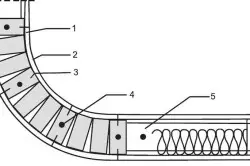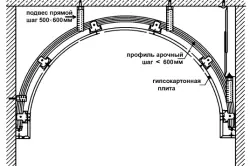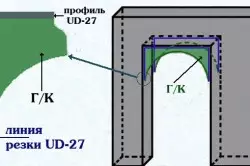Non-shaped partitions kitchen and living room - an indispensable attribute of apartments studios. The lack of a wall between the living room and the kitchen is not only a tribute to fashion, but also helps rationalize the area of the room located under a single ceiling.

Figure 1. Decoration of the doorway without a door. The arches sizes must be combined with the size of the room and the width of the walls in it.
Nevertheless, among the common walls of spaces there are several different purposes, so these zones need at least in the visual separation. It can be performed by installing some design like a rack on the dividing line, to separate the walls, the floor and the ceiling on both sides of the visual boundaries of the zones with different coatings, however, the best way of zoning will be the arches device. It is the most stylish solution when dividing the common space.
The arch creates the feeling that there are 2 rooms in the apartment, while being in each of the studio zones, you do not feel the limited space.
Best Material for Arch - Plasterboard
The easiest way to place the distinction between the kitchen and the living room arch is plasterboard. This material is extremely easy to handle and install and relatively suited. In addition, plasterboard surfaces can be separated by a variety of facing materials. Arch from GLC can be given a different configuration, which gives you the opportunity to make sure the design of the decorative partition. One of the variants of the distinction of 2 zones of the apartment is shown in Fig. one.Preparatory stage
Such structures are easily mounted on the ceiling and connect opposite walls. In order to make the arch between the kitchen and the living room, you need to prepare the following materials and tools:

Figure 2. Bending of the guide profile: 1 - incision on the profile, 2 - plasterboard, 3 - segment of the cut profile, 4 - dowel-nail, 5 - direct profile.
- plasterboard;
- UW- and CW profiles;
- Self-tapping screw 3.5x9.5 mm with press washers;
- Self-tapping screw 3.5x45 mm;
- Dowel-nails 6x60 mm;
- level;
- roulette;
- pencil;
- construction knife;
- Malyary cord;
- a piece of chalk;
- Scissors for metal;
- shock drill;
- screwdriver;
- sickle;
- primer;
- putty;
- roller or brush;
- Spatulas.
Article on the topic: What should the curtains in the living room
First you need to decide which form will be the arch at the exit to the living room, and measure the distance between the walls. It is better if you are on the dimensions to make the side of the side arches. It can be cut out of plywood, radiocarter, paper, etc. With the help of Pekal, it will be easier for you to create 2 identical sidewalls of the decorative partition. This template is useful to you and when making a profile for the future arch.
Remove the boundaries line on the ceiling between zones. Taking this level, apply vertical on the walls. UW-profiles will be attached along the lines to the surfaces. Before assessing, drill in the base of the opening profiles, the step of which should not exceed 30 cm. The number of holes on the willed plackets depends on their length, but in any case there can be no less than 2.

Mounting diagram of plasterboard arches.
Press each guide to the corresponding plane and leave on it with a pencil mark. After that, the ceiling and walls drill a deaf hole under the dowel-nail. Insert the dowels in them, press to the ceiling and walls of the profiles and secure them. Contact meratching guides with self-drawers.
You may want the arches to be located as low as possible. In this case, you will have to connect the walls of another guide, and between it and the ceiling profile you need to insert CW profiles at a distance of 60 cm from each other. They are attached to the guide self-drawing with press washers.
It should be said that the number of ceiling and wall guides will depend on the thickness of the arch. If it is wide, you will need to install 2 rows of profiles. For the arches, a thickness of 10 cm is enough of the 1st row (the profile width is 7.5 cm, the thickness of each sheet of plasterboard is 1.25 cm).
Installation of plasterboard
After mounting the frame, you can attach wiring inside it if you plan to install the lighting devices in the arch. Now cut down the leafs of plasterboard and secure them on the frame. Screwing the screws, place them 15 cm from each other. Do not screw the fastener closer 1 cm from the edge of the sheets. Corner screws Position 10 cm from the corners of HCL.
Article on the topic: Mounting technology of the rafter system
It remains to make the crossbar arches. Cut the profile, as shown in Fig. 2, and screw it to drywall so that the uncut base CW has been located below, there was an arc shape and did not speak behind the edge of the drywall sidewalls.
Of course, you remember that 2 rows of the curved profile will be needed for the wide arch. Between them, the jumpers from CW profiles, reinforcing the design, are screwed with self-reserves. In their ends, cuts are made in the width of the base of the curved plank. The lateral amplifies are bend, and the remaining plates are tightened with arc screws.

Fastening the profile and drywall for the arch.
Since the arc arch has a large radius, then bend the GLC for the arch can be without soaking in the water. The crossbar is manufactured as follows.
- A strip of the required width is cut from the drywall. The arch must overlap not only the profile, but also the edges of the side sheets.
- The length of the sheet must be somewhat larger than the length of the arc profile. Excess then you can cut. At the markup stage, determine where the lamps will be installed (sofets, etc.), and apply marks at the points of them.
- In the workpiece are made of transverse cuts. They are located at 5-7 cm from each other. It is enough to cut the cardboard and the thickness of the gypsum on a small depth (not more than 1/3). The cut side will be addressed up.
- After that, the arch is screwed to the profile. Its installation begins on the center of the arc. It is advisable to screw the screws into every cutting fragment.
- At the end of the installation, drill the crown of the necessary diameter of the hole for the lamps.
Aligning surfaces with spheres
It does not matter that, at first glance, the arch seems stepped. All this is corrected by the shtatlevia. First of all, the surface of the arch is processed by primer. Serpenta sticks on the seams and joints, then putty is applied. It also close holes at the mint of the screws and possible dents. After pouring the first layer, the entire arch is shut off. After the Okurization, she is ready for finishing.
Having finished work, boldly invite friends to the updated living room.
